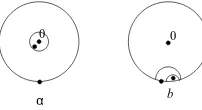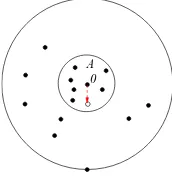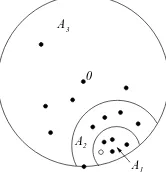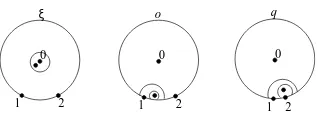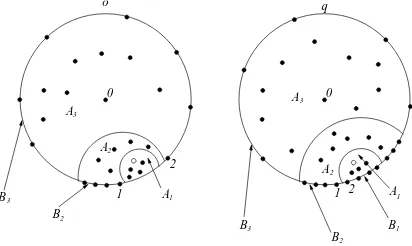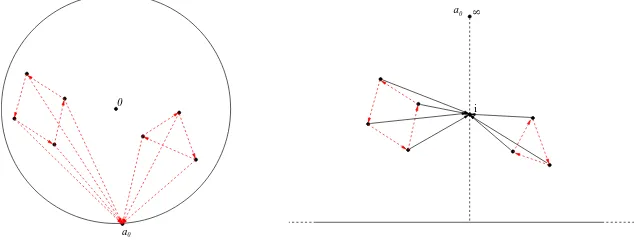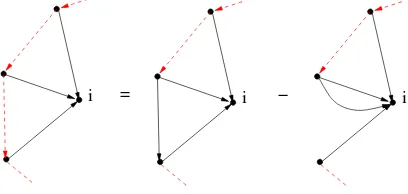Shoikhet’s Conjecture and Duf lo Isomorphism
on (Co)Invariants
⋆Damien CALAQUE and Carlo A. ROSSI
Department of Mathematics, ETH Zurich, 8092 Zurich, Switzerland E-mail: [email protected], [email protected]
Received May 23, 2008, in final form August 29, 2008; Published online September 03, 2008 Original article is available athttp://www.emis.de/journals/SIGMA/2008/060/
Abstract. In this paper we prove a conjecture of B. Shoikhet. This conjecture states that the tangent isomorphism on homology, between the Poisson homology associated to a Poisson structure onRdand the Hochschild homology of its quantized star-product algebra, is an isomorphism of modules over the (isomorphic) respective cohomology algebras. As a consequence, we obtain a version of the Duflo isomorphism on coinvariants.
Key words: deformation quantization; formality theorems; cap-products; Duflo isomorphism
2000 Mathematics Subject Classification: 16E45; 16E40; 81Q30
1
Introduction
In his seminal paper [7] on the deformation quantization of Poisson manifolds M. Kontsevich proved that the differential graded Lie algebra (shortly, DGLA) of polydifferential operators on a smooth manifoldM is formal (i.e. it is quasi-isomorphic, as a DGLA, to its cohomology). As a consequence one obtains that any Poisson structure π on M can be quantized in the sense of [2], and that the Hochschild cohomology of the deformed quantized algebra is isomorphic to the Poisson cohomology of (M, π). Moreover, it is known that the Hochschild cohomology of an associative algebra is naturally equipped with an associative cup-product; and Kontsevich proved that the mentioned isomorphism between Hochschild and Poisson cohomologies is actually mul-tiplicative if M =Rd, using a homotopy argument involving the so-called Kontsevich eye. The proof of this statement, known as the “compatibility with cup-products”, has been clarified in [8], and appeared to have a surprising application to Lie theory [7] (see also [9] and [5]) in providing a new proof, together with a cohomological extension, of the famous Duflo isomorphism [6]. We recall to the reader that the result of Duflo states that the Poincar´e–Birkhoff–Witt map can be modified so that it reduces to an isomorphism of algebras on invariants.
A homological version of Kontsevich’s formality theorem has been formulated by B. Tsygan in [13] and proved by Shoikhet in [10] (in the caseM =Rd) and by Tsygan and Tamarkin in [12], using different approaches. It broadly states that the Hochschild chain complex of the algebra of smooth functions on M is formal as a DG Lie module over the DGLA of polydifferential operators. Again, one obtains as a direct consequence of the general formalism on L∞-algebras, their modules andL∞-morphisms between them, that the Hochschild homology of the deformed quantized algebra is isomorphic to the Poisson homology of (M, π). The present paper is mainly concerned about the multiplicativity of this isomorphism. Namely, Hochschild (resp. Poisson) homology is naturally a graded module over the Hochschild (resp. Poisson) cohomology algeb-ra, and we prove that the isomorphism induced by the Tsygan–Shoikhet formality intertwines
⋆This paper is a contribution to the Special Issue on Deformation Quantization. The full collection is available
these module structures (both cohomology algebras being themselves isomorphic thanks to the compatibility with cup-products). We call our result the “compatibility with cap-products”.
As in the cohomological situation, this compatibility with cap-products has an application to Lie theory in providing a version of the Duflo isomorphism for coinvariants.
The main goal of this paper is to present a short and comprehensible proof of this conjecture (which is a particular case of a more general result, whose detailed proof is presented in [4]). Here the proof also relies on a homotopy argument, Kontsevich’s eye being replaced by the I-cube, this time being a manifold with corners of dimension 3.
The paper is organized as follows. In Section 2 we state the main result we mentioned in this introduction. Section 3 is a brief reminder on Kontsevich’s and Shoikhet’s configuration spaces and their compactifications; we also mention how they are related to each other, a fact which will play a central rˆole in some later computations. In Section4we recall the construction of Kontsevich’s and Shoikhet’s formality L∞-quasi-isomorphisms. This is the first time where the configuration spaces that were introduced in the previous section appear operatively. Sec-tion5 is the heart of the paper. It contains the proof of the main result, for which compactified configuration spaces (and integrals over them) play a crucial rˆole. We finally end the paper with the proof of a version of the Duflo isomorphism for coinvariants, which we obtain as a conse-quence of our main result; we only observe that we prefer to give a direct computational proof, as opposed to the proof of the same result in [10], where it was proved under the assumption that the conjecture (whose proof is the core of this paper) were true.
2
The main result
For the manifold V = Rd, we consider the differential graded Lie algebras (shortly, DGLA) Tpoly• (V) and D•poly(V) of polyvector vector fields on V and of polydifferential operators onV respectively.
Further, letγ be a solution of the Maurer–Cartan equation in T•
poly(V) of the form
γ =~π, (1)
where π is a bivector field and ~ a formal parameter (therefore in particular π is a Poisson structure). The Formality Theorem of Kontsevich [7] implies that the polydifferential operator
B =U(γ) =X
n≥1
1
n!Un(γ, . . . , γ| {z } n
)
Un being the Taylor components of theL∞-quasi isomorphism betweenTpoly• (V) and Dpoly• (V),
satisfies the Maurer–Cartan equation in the DGLA D•
poly(V)[[~]] of (series of) polydifferential
operators on V, viewed as a subcomplex of the Hochschild cochain complex of theC[[~]]-algebra A=C∞(V)[[~]].
We denote byµ the usual multiplication on the algebraA: it may be viewed as an element of Dpoly• (V)[[~]] of degree 1, and the sumµ+B specifies an associative product⋆ onA, which is a deformation of the usual product on A, and which moreover satisfies
f ⋆ g−g ⋆ f = 2~hπ,df∧dgi+O(~2).
In other words, ⋆ is a quantization of the Poisson structureπ onV in the sense of [2].
The DGLA Tpoly• (V) possesses an associative product ∪, namely the usual ∧-product on Tpoly• (V), and a solution γ of the Maurer–Cartan equation defines, by means of the Schouten– Nijenhuis bracket1, a differentialγ·= [γ, ] onT•
poly(V) w.r.t. ∪.
1We observe that, if we follow the sign conventions of [1], we have then to modify the Schouten–Nijenhuis
bracket as [α, β]′
The (negatively graded) deRham complex Ω−•(V) of differential forms on V is naturally a differential graded module (shortly, DGM) over the DGLAT•
poly(V): the extensions of the Lie
derivative L by means of the Cartan formula and of the contraction operatorιdefine respectively a differential Lγ, forγ as in (1), and an action∩ ofTpoly• (V) on Ω−•(V).
On the other hand, forγ as above, there is a product ∪ (of degree 1) on the (shifted by 1) Hochschild cochain complexC•(A, A)[1] of A with values inA,
(ϕ∪ψ)(a1, . . . , ap+q) =ϕ(a1, . . . , ap)⋆ ψ(ap+1, . . . , ap+q).
Additionally, the Hochschild differential dHon the Hochschild cochain complex ofAis modified
to the Hochschild differential dH,⋆ w.r.t. ⋆. All these structures descend to the subcomplex of
polydifferential operators on V.
For the algebraA, we consider the (negatively graded) Hochschild chain complexC−•(A, A). For γ as (1), there is an action ofC•(A, A)[1] on C
−•(A, A) via
ϕ∩(a0|a1| · · · |an) = (a0⋆ ϕ(a1, . . . , am)|am+1| · · · |an),
if m ≤ n; if m > n, the action is trivial. Furthermore, we also have the differential b⋆ on
C−•(A, A), which modifies the usual Hochschild differential b on C−•(A, A). The previous formula defines also an action of the DGLA of polydifferential operators on V on C−•(A, A).
We denote by Sn, n ≥ 0, the Taylor components of the L∞-quasi-isomorphism S from the L∞-module C−•(A, A) to the DGM Ω•(V)[[~]], both over Tpoly• (V), constructed in [10]. The DGM structure of Ω•(V)[[~]] overT•
poly(V) comes from the Lie derivative of polyvector fields on
differential forms, while, as shown in [10], composition of theL∞-quasi-isomorphismU with the action L of Hochschild cochains on Aon Hochschild chains gives C−•(A, A) the structure of an L∞-module overTpoly• (V).
For a solution γ of the Maurer–Cartan equation as in (1), we consider the following linear maps:
for a general polyvector field α onV, resp. Hochschild chain con A.
Theorem 1. For a solution γ of the Maurer–Cartan equation as in (1),(2) is a quasi-isomor-phism of complexes
Uγ : Tpoly• (V)[[~]], γ·
→ D•poly(V)[[~]],dH,⋆,
which additionally preserves the products in the corresponding cohomologies,
[Uγ([α]∪[β])] = [Uγ([α])∪ Uγ([β])],
square brackets denoting cohomology classes.
We refer to [7,8] for the proof of Theorem 1. The main result of this paper is the proof of Conjecture 3.5.3.1 in [10], which we may state in the following
Theorem 2. For a solution γ of the Maurer–Cartan equation as in (1),(3) is a quasi-isomor-phism of complexes
Sγ : (C−•(A, A),b⋆)→(Ω•(V)[[~]],Lγ)
and additionally preserves the action of T•
poly(V) in the corresponding cohomologies,
[[α]∩ Sγ([c])] = [Sγ(Uγ([α])∩[c])],
3
Conf iguration spaces and their compactif ications
We briefly discuss in this Section configuration spaces of i) points in the complex upper-half plane Hand on the real axis R, andii) points in the interior of the punctured unit diskDand on the boundary S1, and their compactifications `a la Fulton–MacPherson.
3.1 Conf iguration spaces of points in the upper half-plane
For a pair of non-negative integers (n, m), the (open) configuration space C+
n,m is defined as
Cn,m+ ={(p1, . . . , pn, q1, . . . , qm)∈ Hn×Rm: pi 6=pj, i6=j, q1<· · ·< qm}/G2,
whereG2is the semidirect productR+⋉R, acting via rescalings and translations. If 2n+m−2≥
0, Cn,m+ is a smooth real manifold of dimension 2n+m−2. We may consider more general configuration spacesCA,B+ , whereA is any finite set andB is any ordered finite set.
The configuration spaceCn is defined as
Cn={(p1, . . . , pn)∈Cn: pi 6=pj, i6=j}/G3,
where G3 is the semidirect product R+⋉ C, acting via rescalings and complex translations. If
2n−3 ≥ 0, Cn is a smooth real manifold of dimension 2n−3. Again, we may consider more
general configuration spaces CA, for any finite setA.
Both configuration spacesCA,B+ and CA are orientable, see e.g. [1].
Configuration spacesCA,B+ andCAadmit compactifications `a la Fulton–MacPherson, denoted
by CA,B+ and CA respectively: they are smooth manifolds with corners and we refer to [7, 8, 3]
and [4] for their explicit constructions.
3.2 Conf iguration spaces of points in the punctured disk
As in Subsection3.1, for a pair of non-negative integers (n, m),m≥1, the (open) configuration space D+
n,m is defined as
D+n,m=
(
(p1, . . . , pn, q1, . . . , qm)∈(D×)n×(S1)m : (
pi 6=pj, i6=j,
q1 <· · ·< qm < q1,
)
/S1,
where D× denotes the punctured unit disk, and where we introduced a cyclic order onS1; the group S1 acts by rotations. If 2n+m−1 ≥ 0, Dn,m+ is a smooth real manifold of dimension 2n+m−1. As before, we may consider configuration spaces D+A,B, whereA is any finite set and B is any cyclically ordered finite set. When|B|= 1, we omit the superscript +.
For a positive integern, we consider the configuration space
Dn=(p1, . . . , pn)∈(C×)n: pi6=pj, i6=j /R+,
where R+ acts by rescaling. It is obviously a smooth real manifold of dimension 2n−1, when 2n−1≥0. We may consider configuration spaces DA, withA any finite set.
Finally,D+A,B and DAare orientable, by the same arguments as in [1].
Configuration spaces D+A,B and DA, admit compactifications `a la Fulton–MacPherson,
de-noted byDA,B+ and DA respectively, which are smooth manifolds with corners.
i) There is a subsetA1 ofA, obeying 1≤ |A1| ≤ |A|, such that
∂A1,0D
+
A,B∼=DA1× D
+
A\A1,B. (4)
Clearly, 2|A1| −1≥0 and 2(|A| − |A1|) +|B| −1≥0. Intuitively, this corresponds to the
situation, where points in D× labelled byA
1 collapse together to the origin.
ii) There is a subsetA1 ofA, obeying 2≤ |A1| ≤ |A|, such that
∂A1D
+
A,B∼=CA1× D
+
A\A1⊔{•},B. (5)
We must impose 2|A1| −3 ≥ 0 and 2(|A| − |A1|+ 1) +|B| −1 ≥ 0. Intuitively, this
corresponds to the situation, where points in D× labelled by A
1 collapse together to
a single point inD× labelled by•.
iii) Finally, there is a subsetA1 of A and an ordered subset B1 of successive elements of B,
obeying 0≤ |A1| ≤ |A|and 2≤ |B1| ≤ |B|, such that
∂A1,B1D
+
A,B ∼=CA+1,B1 × D
+
A\A1,B\B1⊔{•}. (6)
We impose 2|A1|+|B1| −2≥0 and 2(|A| − |A1|) + (|B| − |B1|+ 1)−1≥0. Intuitively, this
corresponds to the situation, where points inD× labelled byA1 and points inS1 labelled
by B1 collapse together to a single point inS1 labelled by•.
3.3 An identif ication between compactif ied conf iguration spaces
We may use the action of S1 to construct a section of D+
A,B, namely we fix one point◦ inS1
to 1. This section is diffeomorphic, by means of the M¨obius transformation
ψ : H ⊔R −→ D⊔S1\{1}; z 7−→ z−i z+ i,
whereDis the unit disk, to a smooth section ofCA+⊔{•},B\{◦}, given by fixing one point•in the complex upper half-plane H to i by means of the action ofG2.
Then, the compactified configuration spaceD+A,Bcan be identified withCA+⊔{•},B\{◦}, and we observe that the cyclic order on the points inS1 translates naturally into an order on the points
on the real axisR.
We further consider the manifoldDA, and notice the identificationDA∼=CA⊔{•}: to be more precise, by means of complex translation, we may put one point • in Cn+1 at the origin, and
using rescalings, one can put the remaining points in the punctured unit disk with boundary. Analogously as before, the compactificationDA ofDA can be identified withCA⊔{•}.
We consequently identify the codimension 1 boundary strata ofD+A,Bwith those ofCA+⊔{•},B\{◦}
(higher codimension can be worked out along the same lines very easily):
i) A boundary stratum as in (4) corresponds to the situation, where points labelled byA1⊔{•}
collapse together to a single point in H, which takes the rˆole of the marked point•. ii) A boundary stratum as in (5) corresponds to the situation, where points labelled by A1
collapse together to a single point in H, which will not be the new marked point •. iii1) A boundary stratum as in (6), where ◦∈/ B1, corresponds to the situation, where points
labelled by A1⊔B1 collapse to a single point in R, which will not be the new marked
point ◦.
iii2) Finally, a boundary stratum as in (6), where ◦ ∈B1, corresponds to the situation, where
points labelled by the set A\A1⊔ {•} ⊔B\B1 collapse to a single point inR, which will
4
Explicit formulæ for the formality morphism
for cochains and chains
Here is a short review of the formulæ we will need to construct the aforementioned L∞ -quasi-isomorphismsU and S.
4.1 The L∞-quasi-isomorphism U
For the sake of simplicity, we denote by [n], for a positive integern, the set{1, . . . , n}. For any pair of non-negative integers (n, m), such that 2n+m−2 ≥0, an admissible graph Γ of type (n, m) is by definition a directed graph with labels obeying the following requirements:
i) The set of vertices VΓ is given by [n]⊔[m]; vertices labelled by integers in [n], resp. [m],
are called vertices of the first, resp. second type; further, the labelling of vertices of the first type specifies an order on them. The set of vertices factorizes into VΓ = VΓ1 ⊔VΓ2,
whereVΓ1, resp.VΓ2, is the set of vertices of the first type, resp. second type.
ii) Every edge inEΓ starts at some vertex of the first type; there is at most one edge between
any two distinct vertices of Γ; no edge starts and ends at the same vertex.
For a given vertex v of Γ, we denote by star(v) the subset ofEΓ of edges starting at v: then,
we assume that, for any vertex of the first type v of Γ, the elements of star(v) are labelled as (e1v, . . . , e|vstar(v)|). By definition, thevalenceof a vertexv is the cardinality of the star ofv. The
set of admissible graphs of type (n, m) is denoted by Gn,m.
We also need the following lemma, borrowed from [7], to which we also refer for a more careful explanation of the origins of the form ω.
Lemma 1. There exists a smooth 1-formω onC2,0, with the following properties:
i) The restriction ofω to the boundary stratumC2 =S1 equals the deRham differential of the
angle function measured in counterclockwise direction from the positive imaginary axis. ii) The restriction of ω to C1,1, where the first point in the complex upper half-plane goes to
the real axis, vanishes.
For any pair of non-negative integers (n, m), such that 2n+m−2 ≥ 0, there are natural smooth projections from Cn,m+ onto C2,0 (provided n ≥2) or onto C1,1 (if n, m ≥ 1), extending
the natural projections on the open configuration spaces.
To an admissible graph Γ of type (n, m) is associated its Kontsevich’s weightWΓ via
WΓ=
Z
Cn,m+
^
e∈EΓ ωe =
Z
C+n,m
ωΓ, (7)
where, for an edgeeof Γ,ωe denotes the pull-back ofω toCn,m+ via the projectionπefrom Cn,m+
onto C2,0, onto the pair of points labelled by the endpoints ofe. The labelling of Γ specifies an
order of the forms ωe in the above product.
To an admissible graph Γ of type (n, m), tonpolyvector fieldsγ1, . . . , γn and tomfunctions
f1, . . . , fm on V, such that|star(k)|=|γk|+ 1, k= 1, . . . , n, we associate a function
UΓ(γ1, . . . , γn)(f1, . . . , fm)
by the following rule: to a vertexvof the first type, resp. second type, we associate the polyvector field γv, resp. the functionfv. For a function I from EΓ to [d], we associate to the vertex v of
the first type, resp. second type, the function
ϕIv =γI(e1v),...,I(e |star(v)| v )
with the same notations as before. The function I labels edges of Γ by (standard) coordinates of V. Then, we have the following assignment, for an admissible graph Γ of type (n, m):
UΓ(γ1, . . . , γn)(f1, . . . , fm) = X
I:EΓ→[d]
Y
v∈VΓ
Y
e∈EΓ:e=(∗,v) ∂I(e)
ϕIv. (8)
It is clear that UΓ, with Γ as above, mapsn polyvector fields {γ1, . . . , γn} to a polydifferential
operator of (shifted) degree m−1 by its very construction.
Finally, we define then-th Taylor component Un of Kontsevich’s L∞-quasi-isomorphism U by combining (7) and (8), namely
Un= X
m≥0
X
Γ∈Gn,m
WΓUΓ. (9)
Theorem 3 (Kontsevich). The Taylor components (9)combine to anL∞-quasi-isomorphism
U :Tpoly• (V)→ Dpoly• (V),
of L∞-algebras, whose first order Taylor component reduces to the Hochschild–Kostant–Rosen-berg quasi-isomorphism in cohomology.
For a proof of Theorem3, we refer to [7].
4.2 The L∞-quasi-isomorphism S
An admissible graph of type (n, m), for any two non-negative integers such that 2n+m−1≥0, is a directed labelled graph Γ as in Subsection4.1, with the only difference that there is a special vertex, labelled by 0, from which edges can only depart; the vertex 0 belongs neither to vertices of the first type nor of the second type. The other requirements and notations from Subsection4.1 remain unaltered. The set of admissible graphs of this kind of type (n, m) is denoted byGn,m,0.
A (partial) counterpart of Lemma1in this framework is the following lemma. We define a smooth 1-form on the configuration spaceC3,0 via
ϕD(p, q, r) =ϕ(q, r)−ϕ(q, p),
for any three pairwise distinct pointsp,q,r inH ⊔R: we then setωD = dϕD.
Lemma 2. The 1-formωD extends to a smooth1-form onC3,0, with the following properties:
i) its restriction to C2,1, when q approaches the real axis, vanishes;
ii) its restriction to C2,0× C1,1, when p and q collapse together to the real axis, equals −π1∗ω;
iii) its restriction to C2× C2,0, when p and q collapse together in the upper half-plane, equals
π2∗ω−π1∗ω;
iv) its restriction toC2,0× C1,1 (resp.C2× C2,0), whenp andr collapse together to the real axis
(resp. in the upper half-plane), vanishes;
v) its restriction to C2,0× C1,1, when q and r collapse together to the real axis, equals π1∗ω;
vi) its restriction to C2× C2,0, when q and r collapse together in the upper half-plane, equals
π1∗ω−π2∗ω.
• if neither inorj lies in{0,1}, then ωD,e:=π(0∗,i,j)ωD, where
π(0,i,j) : Dn,m+ ∼=Cn++1,m−1−→ C3,0, (z0, . . . , zn, z2, . . . , zm)7−→(z0, zi, zj);
• ifi= 0 and j6= 1, then ωD,e :=π∗(i,j)ω, where
π(i,j) : Dn,m+ ∼=Cn++1,m−1−→ C2,0, (z0, . . . , zn, z2, . . . , zm)7−→(zi, zj);
• ifj= 1 and i6= 0, then ωD,e := p∗(i,j)ω, where
p(i,j) : Dn,m+ −→ D1,1 ∼=C2,0, (z1, . . . , zn, z1, . . . , zm)7−→(zi, zj);
• ifi= 1 orj = 0 or (i, j) = (0,1), then ωD,e = 0.
Then, as above,
ωD,Γ:=
^
e∈E(Γ)
ωD,e
defines a differential form onD+n,m.
Definition 1. The Shoikhet weightWD,Γ of the directed graph Γ is
WD,Γ:=
Z
D+n,m ωD,Γ.
We consider an admissible graph in Gn,m,0, such that |star(0)| = l. To n polyvector fields
{γ1, . . . , γn} on V, such that |star(k)| = |γk|+ 1, k = 1, . . . , n, and to a Hochschild chain
c= (a0|a1| · · · |am−1) of degree−m+ 1, we associate anl-form onV (whose actual degree is−l,
following the grading introduced in [10]) via
hα, SΓ(γ1, . . . , γn, c)i=UΓ(α, γ1, . . . , γn)(a0, . . . , an).
Finally, then-th Taylor componentSn of theL∞-quasi-isomorphismS from theL∞-module C−•(A, A) to theL∞-module Ω−•(V) over Tpoly• (V) is given by
Sn= X
m≥1
X
Γ∈Gn,m,0
WΓ,DSΓ. (10)
Theorem 4 (Shoikhet). The Taylor components (10) combine to an L∞-quasi-isomorphism
S :C−•(A, A)→Ω−•(V),
of L∞-modules over Tpoly• (V), whose 0-th order Taylor component reduces to the Hochschild– Kostant–Rosenberg quasi-isomorphism in homology.
We refer to [10] for the proof of Theorem 4.
5
Compatibility between the actions of polyvector f ields
on forms and Hochschild chains
In this Section we sketch the proof of Theorem2, Section2, whose strategy owes to the homotopy argument used in [7,8]; for a more detailed version of the proof of Theorem 2 in an even more general case, we refer to [4].
We must consider separately the case, whereSγ acts on Hochschild chainsi) of degreem= 0
5.1 The space D1
,1 and Hochschild chains of degree 0
By the definition of the action ∩, if c has degree 0, the only Hochschild cochains acting on c non-trivially must be functions, in which case the action is simply multiplication on the right w.r.t. the product ⋆.
We consider the curveℓ on the configuration space D1,1, with initial point on α, and final
point b, which corresponds to the following embedding of the open unit interval into D1,1:
✁ ✁ ✁ ✁ ✁ ✁ ✁ ✁ ✁ ✁ ✁ ✁ ✁ ✁ ✁ ✁ ✁ ✁ ✁ ✁
The subset Yn,m+ of D+n,m, for n ≥ 1, consisting of those configurations, whose projection ontoD1,1belongs to the curveℓ, is a smooth submanifold with corners ofDn,m+ of codimension 1.
Pictorially, a typical configuration inYn,1 looks like as follows:
0
Figure 3. A typical configuration inYn,1.
The dashed line represents the curve, along which the first point inD×(labelled by◦) moves, going from the origin to the unit circle.
We are interested in the boundary strata ofYn,1 of codimension 1, which correspond to the
chosen point on the pupil α and to the point bof D1,1, namely
i) configurations in Dn,1, whose projection onto D1,1 is the initial point of the curve ℓ(the
corresponding strata are denoted collectively by Yn,01);
ii) configurations in Dn,1, whose projection onto D1,1 is the final point of the curve ℓ (the
Let γ be a solution of the Maurer–Cartan equation as in (1), α a polyvector field on V of degree −1 andc=a0 a Hochschild chain of degree 0 for the algebra A.
Proposition 1. For γ, α and c as above, the following identities hold true:
α∩ Sγ(c) = we only give a sketch of such evaluations, referring to [4] for all details.
By construction, all admissible graphs Γ appearing in the expressions on the right-hand side of (11) and (12) have all vertices of the first type of valence 2, except the vertex labelled by 1, which in this case has valence 0.
First, for any admissible graph Γ inGn+1,1,0, the weightWD,0 Γ vanishes, if 1 has at least one
incoming edge: namely, if 1 has one arrow coming from 0, then the integral vanishes, since the angle form is the derivative of a (locally) constant function. Further, Kontsevich’s Vanishing Lemma [7, Lemma 6.4] applies to the remaining cases, whence only the case matters, where 0 and 1 collapse together, and then Lemma2 does the job. Otherwise, the identity
WD,0 Γ=WD,Γ0 (13)
holds true, where Γ0 is the admissible graph inGn,1, obtained from Γ by collapsing the vertices 0
and 1. Here is a graphical representation of a general component Z of Yn0+1,1
0 A
Figure 4. A typical configuration inY0
n,1.
vanishes, unless there are no edges outgoing from A1 or from A2, in which cases the weight
factorizes as
WD,1 Γ|Z =WΓ1WΓ2WD,Γ3, (14)
and Γ1 is the admissible subgraph of Γ, whose vertices of the first type are labelled by A1,
Γ2 is the graph, whose vertices are labelled byA2⊔ {1,2}, and obtained by collapsing Γ1 to the
vertex 2, and Γ3 is the graph, whose vertices are labelled byA3⊔ {1}, obtained by collapsing Γ2
Graphically, a typical configuration in the componentZ looks like as
A1 A
A 0 3
2
Figure 5. A typical configuration inY1
n,1.
First of all, if there is an edge e.g. from A1 to A2, the corresponding contribution vanishes
by means of Lemma 2,i); the same argument implies the claim in all other cases. We observe that this also implies that Γi,i= 1,2,3, is admissible.
Further, the first two factors in the factorization of the weightW1
D,Γ reduce to usual
Kont-sevich’s weights, again in virtue of Lemma 2,v).
The curveℓ in D1,1 “interpolates” between Yn0+1,1 and Yn1+1,1: we may evaluate weights of
admissible graphs inGn+1,1,0 on the remaining boundary strata of codimension 1 ofYn+1,1, and,
by means of Stokes’ Theorem, this implies that (11) and (12) coincide at the level of cohomology; for a complete discussion of the corresponding homotopy formula, we refer to [4].
5.2 The space D+
1,2 and Hochschild chains of higher degree
We prove now Theorem 2 in the case, where (3) is applied to Hochschild chains c of higher (negative) degree.
The open unit square inCcan be embedded in the open configuration spaceD+
1,2via (s, t)7→
s,1, e2πit, where the square brackets denote equivalence classes w.r.t. the action of S1; we may take a possible closure σ of it in the compactification D+1,2 as follows:
α β
ξ
a
b d
e f
h
j
o
p
q
boundary of the surface interior of the surface
an imbedding of the plane squareσ,
σ
in the open I−cube
0 s 1
e2πit
Figure 6. The boundary ofσin D+ 1,2.
Topologically,D+1,2 is a “cube with two eyes”, or I-cube: we will be mostly interested, in the forthcoming discussion, in the boundary stratum ξ of codimension 1, which is D1 × D0+,2, and
in the boundary stratao,q of codimension 2, which are C1,0× C0+,2× D0+,2 andC1,1× C0+,2× D0,1
1 2
We observe that the straight line on the boundary stratumξcorresponds to the edge{s= 0}, the boundary stratumocorresponds to the edge{s= 1}and the boundary stratumqcorresponds to (a way of imbedding) the point (1,0).
For any two positive integers (m, n), with n≥1 andm ≥2, the subset Yn,m+ of those confi-gurations inD+n,m, whose projection ontoD+1,2 belongs toσ, is a smooth, orientable submanifold with corners of Dn,m+ of codimension 1. Graphically,
0
2 1
Figure 8. A typical configuration inY+
n,m.
We will need the boundary strata ofYn,m+ of codimension 1, corresponding to configurations inDn,m+ , whose projection onto the I-cube is in the boundary ofσ(collectively denoted byYn,m+,∂σ).
More precisely,Yn,m+,∂σ factorizes into eight different types, denoted byYn,m+,x, and we will consider
only x to be the straight line on ξ oroand q.
We consider a solutionγ of the Maurer–Cartan equation as in (1), a polyvector fieldα onV, and a Hochschild chain c= (a0| · · · |am) in A,m≥1.
Proposition 2. Forγ,α and cof degree −m≤ −1 as above, the following identities hold true:
α∩ Sγ(c) =
We observe that, for any admissible graph Γ in Gn+1,m,0, the weight WD,ξ Γ vanishes, if the
vertex 1 has at least one incoming edge, by the very same arguments sketched in the proof of Proposition1. Otherwise, the identity
WD,ξ Γ=WD,Γ0
holds true, where Γ0 in Gn,m,0 is obtained from Γ by collapsing the vertices 0 and 1: this
generalizes (13) in the proof of Proposition 1, and the proof uses almost the same arguments. On the other hand, a general component Z of the boundary strata of Yn,m+,o, resp. Yn,m+,q has
Figure 9. Typical components of Y+,o n,mandY
+,q n,m.
We consider a component Z of Yno+1,m as in (17), resp. of Ynq+1,m as in (18), and for an admissible graph Γ as before, we denote by Γ1 the admissible subgraph of Γ, whose vertices are
labelled by A1⊔B1, by Γ2 the graph, whose vertices are labelled by A2⊔B2, and obtained by
collapsing Γ1 to a single vertex, and by Γ3 the graph, whose vertices are labelled by A3 ⊔B3,
obtained by collapsing Γ2 to a single vertex.
The weightWD,o Γ, restricted to a componentZ ofYn++1,o,m as above vanishes, unless there are
equals the degree of the integrand, which, by the above reasonings, is precisely 2(|A1|−1)+|α|+1
(since all vertices of the first type in A1 are 2-valent except the first vertex): therefore, the
integral is non-trivial only if |α|=−1.
The weightWD,q Γ, restricted to a componentZ ofYn++1,q,m as above vanishes, unless there are no edges going from A1 to A2 or A3, or from A2 to A3, |B2| = 2, and |B1| = |α|+ 1 (which
implies thatα has degree bigger or equal than 0). In such cases, the weightWD,o Γ factorizes as
with 1≤ |B1|. Dimensional reasons as in the case of a component Z of Yn++1,q,m force the degree
ofαto be bigger or equal than 0: namely, the degree of the third integrand is 2(|A1|−1)+|α|+1,
and the integral is non-trivial only if it equals 2|A1|+|B1| −2. Since 1≤ |B1|, the non-triviality
condition forces |α|=|B1| −1, whence the claim.
This result obviously generalizes (14) in the proof of Proposition1, and its proof is the same
as the proof of (14).
The surface σ “interpolates” between the boundary strata Yn++1,ξ,m, Yn++1,o,m and Yn++1,q,m: the “interpolation” in this situation is of course more complicated than the one in Subsection 5.1, since we have to keep track of the boundary ofσ. In fact, the weighted sums as in (15) and (16), where we integrate over boundary strata of Yn++1,x,m,x=h, j, p, vanish; the weighted sums over the remaining boundary strata of Yn++1,m can be also explicitly evaluated, and, by means of Stokes’ Theorem, they produce a homotopy formula, proving that the left-hand sides of (15) and (16) coincide at the level of cohomology.
6
Duf lo isomorphism on (co)invariants revisited
Let gbe a finite dimensional Lie algebra over C.
First of all, the(modified) Duflo element[6] is defined via
J := dete
ad/2−e−ad/2
ad
∈bS(g∗)g.
We have a morphism ofg-modules
D := sym◦(J1/2·) : S(g) −→ U(g),
where U(g) is the Universal Enveloping Algebra ofg, and sym denotes the usual symmetrization
map from the symmetric algebra S(g) to U(g).
The following result generalizes to coinvariants the well-known Duflo isomorphism [6].
Theorem 5. The map D restricts to an isomorphism of algebras S(g)g−→˜ U(g)g = Z U(g)
on invariants, and induces an isomorphism of S(g)g-modules S(g)g−→˜ U(g)g = A U(g)
on coinvariants.
HereZ(B) denotes the center of an algebra B, and A(B) =B/[B, B] its abelianization. We sketch here a proof of Theorem 5 in the spirit of the approach of [7, 9] to the original Duflo isomorphism.
We consider the Kirillov–Kostant–Souriau Poisson bivectorπong∗ and associated product⋆.
Since the product⋆obeysx ⋆ y−y ⋆ x= [x, y]g2, viewingx, y∈gas linear functions ong∗, there
is an algebra morphism
I : U(g)−→ S(g), ⋆;x7−→x.
The mapI−1◦ U
γ induces an algebra isomorphism by means of Theorem1, Section 2,
S(g)g=Z S(g),{,}−→ Z U(g)= U(g)g
while, dually,Sγ◦Iinduces an isomorphism of S(g)g-modules by means of Theorem2, Section2,
U(g)g=A U(g)
−→ A S(g),{,}= S(g)g.
In [11], the restriction of Uγ to S(g) has been shown to be the identity, which, coupled with
Kontsevich’s discussion [7, Section 8], implies thatI−1◦ U
γ=I−1 =D: S(g)→U(g).
Shoikhet’s proof of the fact that the restriction of Uγ to functions is the identity can be
summarized as follows: for any function f ∈ S(g), Uγ(f) is expressed only via so-called inner
wheels, whose weights vanish by the main result of [11]. Pictorially, an inner wheel looks like as follows:
i
8
0
Figure 10. An inner wheel.
Theorem5follows then from the following
Proposition 3. The restriction of Sγ onS(g) coincides with the identity map.
Proof . By the arguments of [10, Paragraph 3.6.1], the only admissible graphs contributing non-trivially to Sγ are of the form
a0
a0
0
i
8
Figure 11. A typical admissible graph inSγ on functions and its counterpart in the upper half-plane.
Further, we use a correspondence between weights of admissible graphs inGn,1,0 and
admis-sible graphs in Gn+1,0, by means of the M¨obius transformation
ψ : H ⊔R −→ D⊔S1\{1}; z 7−→ z−i z+i,
which induces (see Subsection 3.3) isomorphisms Cn+1,0−→ D˜ n,1, to prove thatSγ = id.
First of all, given onD1,1 the 1-form ωD as in Lemma2, then the 1-formω :=ψ∗ωD on C2,0
is a difference of usual Kontsevich’s angle forms as in Lemma 1. Then the weight WD,Γ of an
formsωe, whenevereis an edge from some vertex (of the first and of the second type) to 1, and
the “new”eis now an edge from the (inverse image of the) starting point to i, andii) differences betweenωe and ωe(i), ifeis an edge between two vertices (of the first and second type, neither
of which is 0) and the new edgeeconnects the (inverse images of the) endpoints, whilee(i) is an edge, whose starting point is the starting point ofeand whose endpoint is i. We have used here the arguments exposed in Appendix 1 of [4], to which we refer for a more detailed discussion, as well as for the properties of ωD. We also used the fact that the form ω vanishes when its final
point goes to infinity, which finally implies the above correspondence.
We observe that dashed arrows denote formsωD,e onDn,1 in the left-most graph of Fig. 11,
while we have used plain, resp. dashed, arrows to denote formsωe onCn+1,0, resp. differences of
such forms, in the right-most graph.
Finally, we use the following graphical calculus for replacing dashed edges by plain ones:
= i − i
i
Figure 12. Replacing dashed edges by plain ones in an inner wheel.
The second graph on the right-hand side has a double edge, whence its weight vanishes. Thus, the Shoikhet weight of the left-most graph in Fig.11 equals the usual Kontsevich weight of the right-most one (i.e. with all edges turned into black ones), which is zero by [11].
We finally observe that Proposition 3 has been proved in Subsubsection 3.6.2 of [10] under the assumption of the validity of Conjecture 3.5.3.1, which is implied by Theorem 2: our proof, on the contrary, is purely based on the main result of [11] and on the properties of the formsωD.
7
Conclusion
In this paper, we have proved Shoikhet’s conjecture using configuration space integrals: it is worthwhile noticing that we did not exploit all boundary strata of the I-cube, which replaces in our homotopy argument Kontsevich’s eye (namely, we made use only of the boundary stratumξ of codimension 1 and of the boundary strata o and q of codimension 2). In fact, Shoikhet’s conjecture can be viewed as a special case of a more general result, which involves a Maurer– Cartan element of a more general shape, i.e. a sum of polyvector fields of different degrees, to which, via Kontsevich’s formality, corresponds also a sum of polydifferential operators, also of different degrees: accordingly, all boundary strata of the surface σ in the I-cube contribute to the proof of this more general result [4].
Acknowledgement
References
[1] Arnal D., Manchon D., Masmoudi M., Choix des signes pour la formalit´e de M. Kontsevich,Pacific J. Math. 203, (2002), 23–66,math.QA/0003003.
[2] Bayen F., Flato M., Fronsdal C., Lichnerowicz A., Sternheimer D., Deformation theory and quantization. I. Deformations of symplectic structures,Ann. Physics111(1978), 61–110.
Bayen F., Flato M., Fronsdal C., Lichnerowicz A., Sternheimer D., Deformation theory and quantization. II. Physical applications,Ann. Physics111(1978), 111–151.
[3] Calaque D., Rossi C.A., Lectures on Duflo isomorphisms in Lie algebras and complex geometry,
http://math.univ-lyon1.fr/∼calaque/LectureNotes/LectETH.pdf.
[4] Calaque D., Rossi C.A., Compatibility with cap-products in Tsygan’s formality and homological Duflo isomorphism,arXiv:0805.3444.
[5] Cattaneo A.S., Keller B., Torossian Ch., Brugui`eres A., D´eformation, quantification, th´eorie de Lie, Panora-mas et Synth`eses, Vol. 20, SMF, Paris, 2005.
[6] Duflo M., Op´erateurs diff´erentiels bi-invariants sur un groupe de Lie,Ann. Sci. ´Ecole Norm. Sup. (4)10
(1977), 265–288.
[7] Kontsevich M., Deformation quantization of Poisson manifolds, Lett. Math. Phys. 66 (2003), 157–216,
q-alg/9709040.
[8] Manchon D., Torossian Ch., Cohomologie tangente et cup-produit pour la quantification de Kontsevich,
Ann. Math. Blaise Pascal10(2003), 75–106,math.QA/0106205.
[9] Pevzner M., Torossian Ch., Isomorphisme de Duflo et la cohomologie tangentielle,J. Geom. Phys.51(2004),
487–506,math.QA/0310128.
[10] Shoikhet B., A proof of the Tsygan formality conjecture for chains, Adv. Math. 179 (2003), 7–37,
math.QA/0010321.
[11] Shoikhet B., Vanishing of the Kontsevich integrals of the wheels, in EuroConf´erence Mosh´e Flato 2000, Part II (Dijon),Lett. Math. Phys.56, (2001), 141–149,math.QA/0007080.
[12] Tamarkin D., Tsygan B., Cyclic formality and index theorems, EuroConf´erence Mosh´e Flato 2000, Part II (Dijon),Lett. Math. Phys.56(2001), 85–97.
